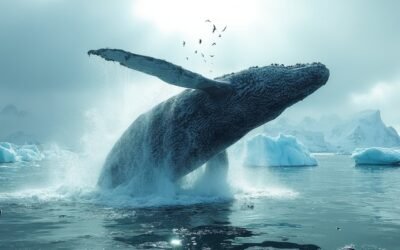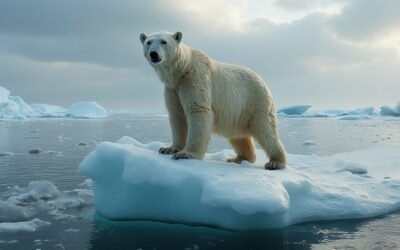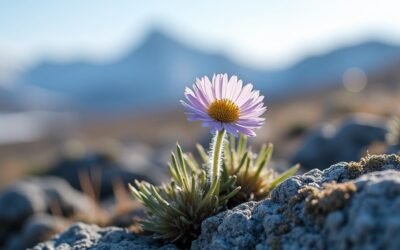In the tundra, climate change has three significant impacts. First, you'll find species distributions shifting northward as temperatures rise, transforming the community structure of this fragile ecosystem. Second, predator-prey dynamics are evolving; as predators adapt to warmer climates, their behaviors and migration patterns alter, leading to cascading effects throughout the food chain. Third, there's a noticeable shift in vegetation from mosses to shrubs and trees, driven by warmer conditions and permafrost thaw, reshaping the landscape and affecting all wildlife. As you explore further, you'll uncover deeper insights into how these shifts are interconnected.
Main Points
- Climate change is driving northward migration of tundra species, altering wildlife habitats and community structures.
- Rising temperatures lead to changes in predator behaviors, reshaping predator-prey dynamics in the tundra.
- Increased shrub density and tree growth in tundra areas transform the physical landscape and ecosystem dynamics.
- Permafrost thaw due to warming impacts soil conditions, affecting vegetation and the entire food chain.
- These environmental shifts necessitate updated conservation strategies to maintain tundra wildlife and ecosystem balance.
Shifting Species Distributions
Climate change is reshaping the tundra, pushing species like caribou and lemmings farther north and altering the dynamics of this fragile ecosystem. As the Arctic experiences global warming, traditional boundaries of the tundra are shifting, causing significant changes in the distribution of key species. This movement isn't just a relocation; it's a transformation of the entire community structure that has thrived for millennia under stable conditions.
These environmental shifts are indicative of broader ecological transformations across the tundra. As you observe the northward migration, it's evident that the habitats and ranges of wildlife are adjusting to the changing climate. This isn't merely about animals moving to cooler areas; it's a complex cascade effect that impacts everything from individual species to the overall health of the ecosystem.
Understanding these mechanisms is vital for conservation efforts aimed at preserving the tundra's biodiversity. By grasping how species distributions are altering, you can better predict future changes and implement strategies to mitigate adverse impacts. The conservation of the Arctic tundra demands a holistic approach, considering how intertwined species and their environments are in this rapidly changing landscape.
Altered Predator-Prey Dynamics
As tundra temperatures rise, predators are adapting their behaviors and expanding their ranges, fundamentally altering the dynamics between them and their prey. This shift, driven by Arctic warming, is reshaping predator-prey dynamics in tundra ecosystems, with profound implications for food webs and species interactions.
You're witnessing a scenario where changes in predator behavior and distribution aren't just essential; they're reshaping prey populations and thereby causing cascading effects on ecosystem balance. For instance, increased predation pressure on certain prey species can lead to significant population declines, tipping the scales towards ecosystem instability.
These altered interactions are vital to understanding as they affect species composition, population dynamics, and the overall community structure in these fragile environments. The environmental shifts induced by climate change are rewriting the rules of engagement in these cold habitats, making it essential to grasp how these changes influence the broader ecological tapestry.
Vegetation and Habitat Changes
Tundra vegetation is shifting from mosses and lichens to shrubs and trees, drastically altering habitats for native wildlife. This change in the Arctic tundra, driven by climate warming, is bringing about significant vegetation shifts. You're seeing shrub density increase, which is transforming the landscape and directly impacting the food sources for herbivores like caribou.
As permafrost thaws, soil conditions are altered, further affecting plant growth and the suitability of habitats. This thaw not only modifies the physical environment but also the ecosystem dynamics within these areas. The interactions among species are becoming more complex as new plants establish and grow, influencing the types of wildlife that can thrive.
These environmental shifts are rapid, yet the response of vegetation is lagging. This delay complicates the adaptations and survival of various species, including migratory birds and polar bears, which rely heavily on specific habitat conditions. The wildlife impact is profound, as changes in vegetation can lead to a cascade of effects throughout the food chain.
As you observe these changes, it's clear that the Arctic tundra is undergoing a transformation that will continue to challenge the balance of existing ecosystems and the wildlife that depend on them.
Frequently Asked Questions
What Are the Environmental Factors That Affect the Tundra?
You're dealing with several environmental factors in the tundra. Permafrost thaw, influenced by warming temperatures, greatly alters soil composition and microbial activity.
Changes in precipitation patterns, atmospheric changes, and increased summer duration affect both plant and animal life. Wind patterns, daylight variability, and glacier retreat also play important roles.
Additionally, the tundra, often considered cold deserts, faces unique challenges from these evolving conditions.
What Is Changing About the Environment in the Arctic Tundra?
In the Arctic tundra, you're seeing drastic changes. Ice is melting and permafrost is thawing, releasing carbon into the atmosphere. Winters are getting shorter, and there's an increase in wildfires.
Invasive species are moving in, pushing out native flora and fauna. Seasons are shifting unpredictably, altering hydrology and causing glaciers to retreat.
These shifts lead to significant biodiversity loss, altering the landscape and the way life can sustain itself in this fragile ecosystem.
Why Is the Tundra Especially Vulnerable to Environmental Disruption?
You're seeing the tundra's vulnerability to environmental disruption because it's a region where permafrost thawing, long winters, and short summers intersect with limited biodiversity and fragile ecosystems.
Cold adaptation, sparse vegetation, and soil instability magnify the impact of changes like ice melting and carbon release.
These factors combine to make the tundra exceptionally sensitive to shifts in the environment, leading to significant ecological consequences.
What Are the Biggest Challenges Facing Plants and Animals Living in the Tundra?
You're facing a tough environment in the tundra, where plants and animals struggle with short growing seasons and nutrient scarcity. The thawing permafrost releases gases, further disrupting habitats. Extreme cold, limited shelter, and high UV exposure pose daily challenges, while wind erosion affects the soil.
Additionally, seasonal migrations, reproductive challenges, and adapting to new predators make survival even tougher. These elements collectively underscore the resilience needed to thrive in such a harsh climate.
Conclusion
As the tundra whispers its transformation tales, you witness an intricate dance of survival and adaptation. Species are migrating, reshaping the ecological fabric. Predator and prey are rewriting their ancient scripts, while the very ground beneath them dresses in new floral patterns.
This evolving stage isn't merely a backdrop but a vivid reminder of nature's resilience and fragility. Embrace these insights, for understanding these shifts is essential in safeguarding the delicate balance of our planet's tundra ecosystems.


